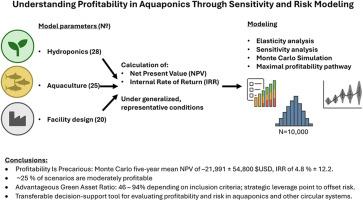通过敏感性和风险模型观察鱼菜共生和盈利能力和可持续性的十字路口
IF 10
1区 环境科学与生态学
Q1 ENGINEERING, ENVIRONMENTAL
引用次数: 0
摘要
水培法将水产养殖废水与水培作物生产相结合,为传统农业提供了一种资源和节水的替代方案。然而,它的经济可行性仍然存在争议,许多商业运营的寿命都很短。本研究开发了一个财务模型框架,通过分析净现值(NPV)和内部收益率(IRR)对水产养殖、水培和设施操作参数变化的敏感性,来评估鱼菜共生的盈利能力和可持续性。建立了73个参数的财务模型。敏感性和弹性分析根据对实际范围内NPV和IRR的影响对参数进行排序。蒙特卡罗模拟估计了正回报的可能性,而截断正态分布的拉丁超立方抽样确定了产生最佳结果的参数组合。应用生命周期分析(LCA)和绿色资产比率(GAR)来评估环境影响和可持续融资的资格。劳动力、管理效率、产量和市场价格是主要的盈利驱动因素;植物收入对盈利能力的影响大于鱼类收入。5年平均净现值为- 21,991±54,800美元;IRR为4.8±12.2%,只有~ 25%的模拟结果为正值。高可变性表明持续的操作漏洞。LCA显示,电力是全球变暖潜值的最大贡献者(中位数为~ 20,000 kg CO2-eq y - 1),其次是基础设施维护。此外,盈利情景的概况与非盈利情景有所不同。GAR得分从46到94%不等,表明欧盟绿色金融工具适合缓冲风险。这种随机建模方法使研究人员能够优化目标参数,运营商能够解决工艺限制,投资者能够评估风险回报权衡。本方法应用于鱼菜共生,可作为风险评估工具转移到其他循环系统。本文章由计算机程序翻译,如有差异,请以英文原文为准。

Aquaponics and the crossroads of profitability and sustainability viewed through sensitivity and risk modeling
Aquaponics integrates aquaculture effluent with hydroponic crop production, offering a resource- and water-efficient alternative to conventional agriculture. However, its economic viability remains contested, with many commercial operations having short lifespans. This study develops a financial modelling framework to evaluate aquaponics profitability and sustainability by analyzing the sensitivity of Net Present Value (NPV) and Internal Rate of Return (IRR) to variations in aquaculture, hydroponics, and facility operational parameters. A 73-parameter financial model was built. Sensitivity and elasticity analyses ranked parameters by their influence on NPV and IRR over realistic ranges. Monte Carlo simulations estimated the likelihood of positive returns, while Latin Hypercube Sampling of truncated normal distributions identified parameter combinations yielding optimal outcomes. Life Cycle Analysis (LCA) and Green Asset Ratio (GAR) were applied to assess environmental impacts and eligibility for sustainable financing.
Labor, managerial efficiency, production yield and market price were dominant profitability drivers; plant revenues influenced profitability more than fish. The mean five-year NPV was −21,991 ± 54,800 $USD; IRR was 4.8 ± 12.2 %, with only ∼25 % of simulations yielding positive values. The high variability suggests persistent operational vulnerability. LCA showed electricity as the largest contributor to GWP (∼20,000 kg CO2-eq y−1 median) followed by infrastructure maintenance. Moreover, the profile of profitable scenarios diverged from non-profitable ones. GAR scores ranged from 46 to 94 %, indicating suitability for EU green-finance instruments to buffer risk. This stochastic modelling approach enables researchers to target parameters for optimization, operators to address process constraints, and investors to assess risk–return trade-offs. Applied here to aquaponics, the methodology is transferable to other circular systems as a risk assessment tool.
求助全文
通过发布文献求助,成功后即可免费获取论文全文。
去求助
来源期刊

Journal of Cleaner Production
环境科学-工程:环境
CiteScore
20.40
自引率
9.00%
发文量
4720
审稿时长
111 days
期刊介绍:
The Journal of Cleaner Production is an international, transdisciplinary journal that addresses and discusses theoretical and practical Cleaner Production, Environmental, and Sustainability issues. It aims to help societies become more sustainable by focusing on the concept of 'Cleaner Production', which aims at preventing waste production and increasing efficiencies in energy, water, resources, and human capital use. The journal serves as a platform for corporations, governments, education institutions, regions, and societies to engage in discussions and research related to Cleaner Production, environmental, and sustainability practices.
 求助内容:
求助内容: 应助结果提醒方式:
应助结果提醒方式:


